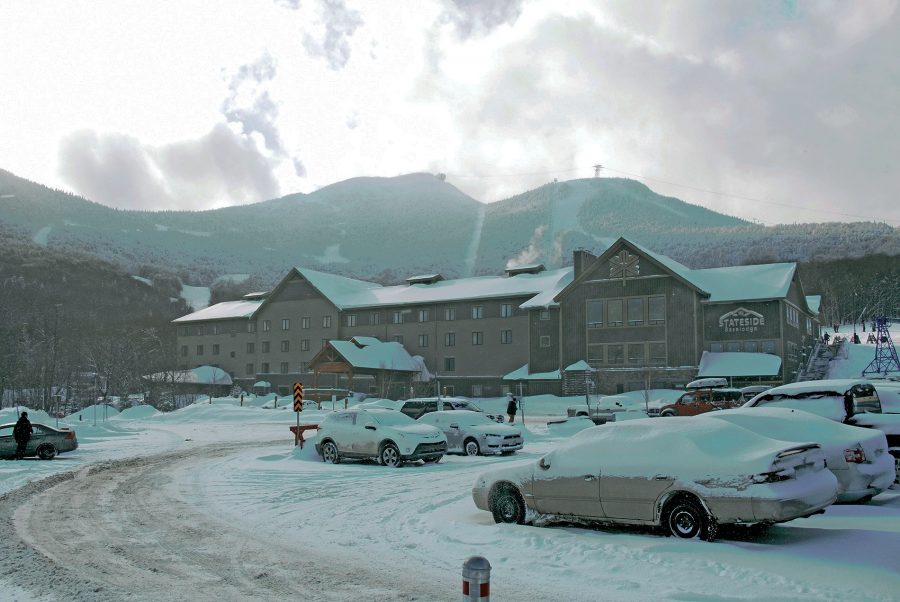Use of new technologies increases energy efficiency at Vermont ski resorts
Jay Peak Stateside Hotel
Mountain resorts eat up a lot of energy to operate on their seasonal schedules. Jay Peak, Sugarbush, Killington and Okemo are all aware of this and understand that sustainability needs to be a huge focus when looking to the future of skiing and snowboarding in Vermont.
Bonnie MacPherson, director of public relations for Okemo, noted that they are always trying to find ways to reduce their energy consumption. She added that they work with Efficiency Vermont to find ways to cut down on costs.
“Through Efficiency Vermont, a couple of years ago there was a snow-gun buy back,” said Macpherson. “They bought back all of the old non-efficient snow-guns. They have worked closely with us to do energy audits, like installing motion detectors for lights around our buildings.”
One of the largest associated energy consumers for resorts deals with the use and management of snowmaking equipment. Mountain Operations worker Corey Guillette has been a part of these processes at Jay Peak for the past 19 years, and notes that water use related to snowmaking is always a critical process to deal with.
“We feed off of a small brook that runs on the mountain,” said Guillette. “We are regulated to have a certain amount of cubic feet of water flow down the brook at all times, and if we don’t have enough water running in the brook we can’t make the amount of snow necessary to keep the mountain open.”
Guillette pointed out that if there is a drought in the fall, they will have very little water for snowmaking. “Usually once we get the first few snowfalls of the season on the mountain, the water flow will increase; this is one of our fights each year.”
At Sugarbush, Candice White, vice president of communications and brand management, says that they have been able to decrease their snowmaking energy consumption by about 20 percent over the last few years with their investments in low-energy equipment.
With one of the highest terrain coverage specs on the east coast of 98 percent, Okemo uses roughly 1,300 efficient HKD tower snow-guns. “With our older guns, we had an air to water ratio of 30 to one, and now with the new guns it’s much more efficient at a one to one usage ratio,” said MacPherson.
Guillette says that some of their earlier snow-guns have nozzles similar to pressure washers, and that the different size heads create the different amounts of gallons per minute that the guns put out. “In the marginal seasons we use smaller nozzles because they use more air, and we can run more guns while making snow at 25 degrees Fahrenheit,” he added.
When it gets colder, Guillette says that they will switch to bigger nozzles. “This means we will use less guns and less air; the air is a big electricity consumer,” he said, “Unlike the electricity used to send the air, the water is going to be sent up the mountain regardless, you need the water to make the snow. The more the merrier when it comes to water.”
All resorts use a reservoir to gather their water for snowmaking. MacPherson says that Okemo uses a 55 million-gallon reservoir that they draw water into. “We have already pumped about 250 million gallons of water onto the mountain this winter, and we will probably end up with about three to four hundred million gallons used by the end of this season,” she added.
Along with saving energy through snowmaking, White noted that at Sugarbush they have transitioned to LED lighting across the resort, as well as offering composting in all of their commercial kitchens. “We have introduced four-way waste stream receptacles bins in our main base lodge,” she said. “We also have an overall Safety, Environmental and Wellness Committee that constantly introduces ways to be more environmentally aware for us.”
Communications and Public Relations Manager at Killington Resort, Michael Joseph, says that with snowmaking, grooming also uses a good amount of fuel, and there is a big electrical use in lift operations too. “Snowmaking for us usually happens between the middle of October and ends near the end of February,” he said. “Having the most lifts on the east coast with 22, we run two lifts seven days a week during the summer, as well as an additional one on the weekends for mountain biking.”
Steve Wright, general manager at Jay Peak, says that they have programs designed to increase the use of carpooling by employees, as well as a no idling policy. “We also use our waste energy from our indoor skating rink to heat our indoor waterpark,” he said.
At Okemo, MacPherson says that they recently swapped the drive for one of their newer installed lifts to the top instead of at the bottom. “Instead of pushing, it now pulls which makes it more efficient to operate,” she said.
White says that several years ago, Sugarbush joined the National Ski Areas Association’s Climate Challenge, where they use tools to track all of their energy consumption: “This required a heavy investment in labor but has allowed us to have a much better understanding of our consumption and also allowed us to set goals for reduction each year.”
Another option that is in full effect at Killington is the Cow Power program developed by Green Mountain Power. “Using the number of dairy farms in the state that are partnered with GMP on this, methane digesters are installed at their farms,” says Joseph. “Cow waste is used to harvest methane, converted to electricity and then sold to us.”
Joseph says that the harvest power is used year-round for their K-1 Gondola as well as at the Peak Lodge on the top of the mountain. “We are the largest consumer in Vermont, and we basically buy that electricity off of the grid from them at a slightly higher rate than regular power,” said Joseph.
Last year at Jay, Guillette said that they held a big energy audit to see what all of their equipment was running at. “We tried lowering the energy consumption by renting generators to take place of our on grid power, but we still had to pay for the fuel that the generators used,” said Guillette. “For this year, we just went with a fixed rate for the kilowatts we were going to use for electricity this season.”
Looking towards future development with energy consumption in mind, MacPherson says that staying on top of technology is a must. “You have to have a viable business in order to keep up and stay ahead of the game with all of the technology and to make investments,” she said. “We also have a master plan dealing with the growth related to lodging and buildings, to help keep everything up to date and efficient as possible.”
Joseph noted that through their parent company at Killington, they have a Chief Sustainability Officer, as well as a local Green Team consisting of a number of management members around the resort. “We meet every two weeks to talk about different issues around the resort, and how we can improve sustainability,” said Joseph. “This is a daily consideration for our mountain ops team, because you can only use up so much electricity before you are charged a higher rate.”
With operational cost on the rise, resorts might be finding themselves between a rock and a hard place when it comes to working this out. As you will witness with any resort, Sugarbush plays a huge role with the overall business throughout their surrounding areas like the Mad River Valley. “Visitors patronize all the local businesses, restaurants, grocery stores, gas stations, retail stores, etc.,” said White. “When our visits are down, local revenue is down — they are intrinsically linked.”
With this in mind, Wright says that there would simply be a ripple felt by anyone who makes a living off of vacationing skiers and riders.
Ski Vermont Communications Manager Chloe Elliott noted that she grew up in a resort town in Vermont, and that she knows what it’s like to feel the effects of a good season and a not-so-good season and the way it impacts the people and businesses within a resort town.
Elliott noted that in case resorts end up having to shorten operation schedules due to a number of long-term issues from climate change to operational costs, the biggest change that could occur would probably be a drop in jobs. “Currently, resorts create 12,000 winter operation job and 22,000 indirect jobs annually; of those 34,000 jobs, approximately 25 percent are year round positions and 75 percent are seasonal.”
As resorts continue to take advantage of all of the offered programs and new developing technologies. Hopefully, they will all prove to be good investments when navigating the possible future effects of climate change in Vermont.







